The 10 Best Superhero Comics of 2018
Main Art by Wilfredo Torres/ Ivan Reis/ Jenny Frison Comics Lists Comics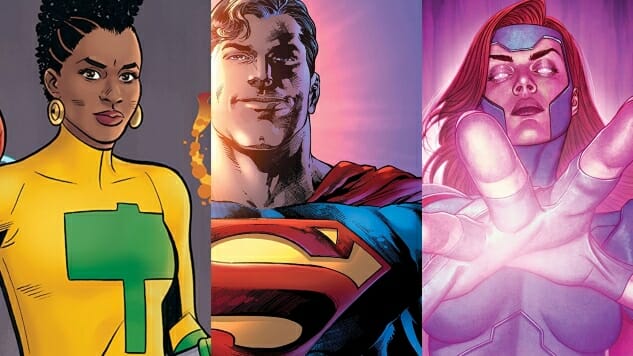
“Hey, wait a minute Paste—didn’t you already publish your big best-of list for 2018? And didn’t that list contain superhero comics, kids comics, horror comics and sci-fi/fantasy comics, all under one big umbrella? What gives?” Well, intrepid Paste reader, you’re not wrong. Paste prides itself on taking as broad a look at the medium of comics as our small team can possibly manage. Our year-end rankings don’t discriminate between capes-and-tights adventures, creepy manga, bonkers webcomics or navel-gazing “literary” graphic novels, but when compiling our master list, we realized that 2018 was a deceptively great year for sequential art, and 25 notable books just didn’t cut it. Before the holidays roll around, we’ll be honoring books that excelled in the specific categories mentioned above. Some will overlap with our main list, but many won’t—and the way rankings shift around may surprise you. A title that stood out when viewed holistically might rank lower when assessed through a specific lens, and books that didn’t make the cut for the master list can easily come out on top of these individual breakdowns. If nothing else, we hope our newly expanded categories send you into 2019 with plenty of reading material.
![]()
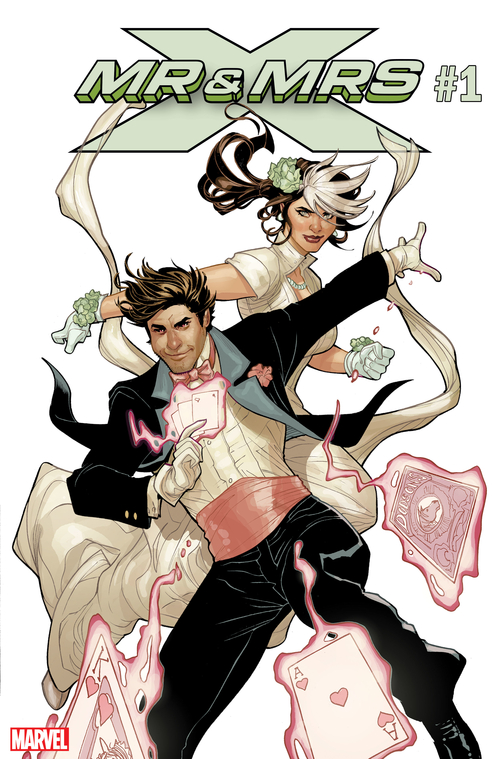
Mr. & Mrs. X Cover Art by Terry Dodson
10. Mr. & Mrs. X
Writer: Kelly Thompson
Artists: Oscar Bazaldua, David Lopez
Publisher: Marvel Comics
It wasn’t a great year for weddings. When X-Men Gold #30 revealed that it wasn’t Kitty Pryde and Colossus who tied the knot, but instead Rogue and Gambit, there were a lot of questions about how exactly that had come about. The honest answer is that the misdirect was an unusual bit of marketing for Mr. & Mrs. X, the legally wedded follow-up to Kelly Thompson’s Rogue & Gambit miniseries. This entry could be easily swapped out for Thompson’s other 2018 triumphs: the conclusion of her celebrated run on Hawkeye and the launch of its spiritual sequel West Coast Avengers. Mr. & Mrs. X gets the nod because we’re suckers for mutants, sure, but also because it finally succeeded at something the X-line has tried and failed to do for years—recapture the glory of the Chris Claremont heyday. Thompson nails the balance of melodrama and action like few X-writers before her, and both Oscar Bazaldua and David Lopez are fully up to the task of rendering steamy Southern lovers, mutant dinner parties, outer-space brawlers and Louisiana assassins with equal skill. Another titles later on in this list revamped the X-Men for the current day, but take note: this is how you pay tribute to Claremont in style. Steve Foxe
![]()

Catalyst Prime: Kino Cover Art by Frazer Irving
9. Catalyst Prime: Kino
Writer: Alex Paknadel
Artist: Diego Galindo
Publisher: Lion Forge
Lion Forge’s nascent Catalyst Prime shared superhero universe has had interesting elements, but has often struggled to stand out in a packed capes-and-tights publishing era. Now that most of the titles have shipped at least two full arcs, it seems that Lion Forge is willing to take a bit more risk. Following nine issues from writer Joe Casey and artists including Jefte Palo, Catalyst Prime: Kino welcomed new creative team Alex Paknadel and Diego Galindo. Incoming readers need not fear: Paknadel and Galindo pick up on the status quo left behind by Casey and crew, but do so in an accessible manner. Super-powered Alistair Meath finds himself homeless, his family having moved on without him—and his country under the thrall of a far-right politician who insists that “The Event” that kicked off the Catalyst Prime universe never even happened. Paknadel is invested in smart, biting sci-fi like Arcadia and the currently running Friendo, and Galindo provides an easy visual bridge from original artist Palo. If you’re looking for an original superhero story with more room to experiment than the average Marvel or DC outing—something in the long, thoughtful (if less grim) legacy of Miracle Man, A God Somewhere and Supreme, consider joining the Kino train before it fully leaves the station. Steve Foxe
![]()
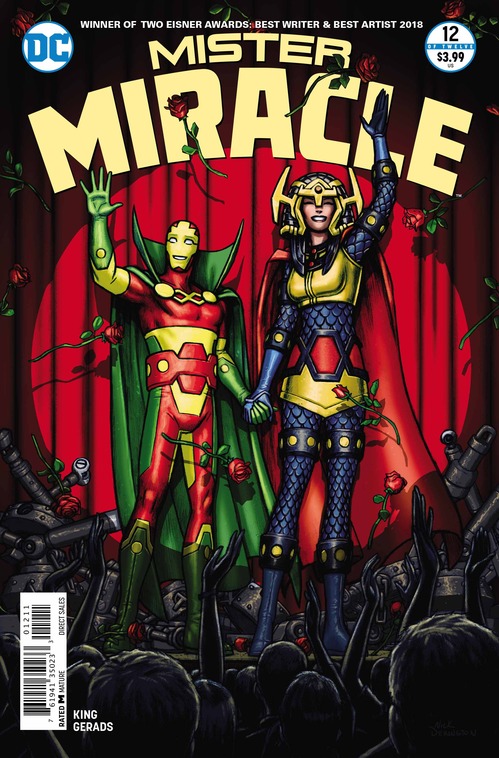
Mister Miracle Cover Art by Nick Derington
8. Mister Miracle
Writer: Tom King
Artist: Mitch Gerads
Publisher: DC Comics
Mister Miracle #1, which came out in 2017, opened with a cult-favorite Jack Kirby Fourth World creation attempting suicide and went on to become one of the most critically acclaimed comics in recent memory. Its balance of interpersonal family drama and cosmic war trauma is perhaps best summed up by an issue in which Mister Miracle and his wife Big Barda navigate a series of deathtraps while discussing how they’d like to remodel their condo. Last month, after dominating the comics discourse for over a year, the curtains finally closed on Tom King and Mitch Gerads’ critical darling, with predictably divisive results. Mister Miracle #11 ended—spoiler alert—with Scott Free seemingly slaying his adopted father Darkseid. Fellow New God Metron appeared in the aftermath and presented the titular hero with a portal to what appeared to be the current DC Universe. We won’t get into how Scott Free responded to Metron’s offer, but rest assured it was a tough call whether or not to include Mister Miracle on this list. Was Mister Miracle #12 the only fitting conclusion, or the biggest letdown of the year? Either way, its shadow loomed over superhero comics in 2018, and it didn’t feel right to let the year pass without acknowledging the sensation. Also of note: King and Lee Weeks’ Freeze-centric Batman arc, the highlight of a similarly controversial year for King’s take on Gotham’s Dark Knight. Steve Foxe
![]()

Captain America Cover Art by Alex Ross
7. Captain America
Writer: Ta-Nahesi Coates
Artist: Leinil Francis Yu
Publisher: Marvel Comics
Given the platform afforded a character like Captain America, Ta-Nahesi Coates and Leinil Francis Yu are crafting not just one of the most relevant superhero comics of the year, but of recent memory. This iteration of Cap has been in the limelight from the moment Coates was announced as the series’ writer, and he’s lived up to the hype throughout a deliberately paced first arc. Dealing with the fallout from Secret Empire and the confusion over whether or not he was a member of HYDRA, Steve Rogers is picking up the pieces of his life and trying to reestablish himself as a force for good—and it’s a story we need. Cap may be a superhero, but what he’s trying to do isn’t unachievable by the average citizen. When Cap goes toe to toe with Taskmaster, he doesn’t pull off any superheroic stunts with his enhanced strength, or even throw his mighty shield. Instead, the idyllic American hero calls back to his training sessions in the streets, the dojo and the gym to knock the skull-faced baddie off his feet and snag a victory. Cap’s strength comes from the diversity of his namesake—and that message is just as important now as it’s always been. Coates and Yu’s Captain America proclaims loudly that being a superhero—being good—isn’t easy, but it is necessary. Captain America is timely and unabashed in its messaging, positioning it irrefutably on this list. (And anyone who doubts the ongoing relevance of these messages should also pick up this year’s annual issue from Tini Howard, Chris Sprouse and Ron Lim, which ably demonstrates Cap’s wartime principles.) Josh Hilgenberg
![]()
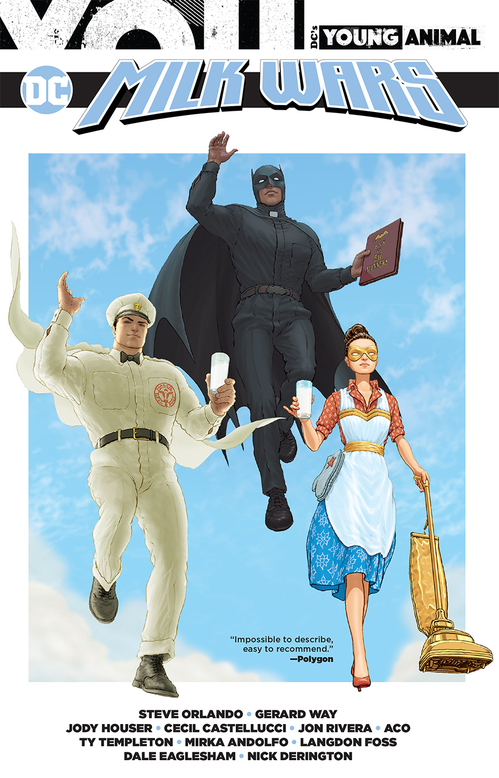
Milk Wars Cover Art by Frank Quitely
6. Milk Wars
Writers: Gerard Way, Steve Orlando, Jody Houser, Cecil Castellucci, Jonathan Rivera
Artists: Aco, Ty Templeton, Mirka Andolfo, Langdon Foss, Dale Eaglesham, Nick Derington
Publisher: Young Animal/ DC Comics
Gerard Way’s Young Animal pop-up imprint was a breath of fresh air at DC Comics when it launched in 2016, capturing the vital transgressive spirit of early Vertigo books with a huge dose of the new—and the weird. The imprint’s initial four ongoing series each seemed to exist in their own bizarre world, which made the idea of a crossover—and with the Justice League of America, no less—a bold, unlikely, potentially disastrous step for the line. Thankfully, the heroes of the DC Universe met the Doom Patrol, Shade, Mother Panic and Cave Carson on Young Animal’s turf, resulting in a gloriously weird five-issue “un-event” centered on milk that homogenizes the publisher’s icons into ‘50s-era stereotypes of repression: Batman serves as a priest, Wonder Woman is more of a wonder wife and Milkman Man…well, you’ll need to read the series to find out his deal. The future of Way’s DC imprint may be hazy—and the JLA incarnation involved in this crossover is but a distant memory—but Milk Wars stands out as one of the strangest, most enthusiastic superhero moments of 2018. Steve Foxe
![]()
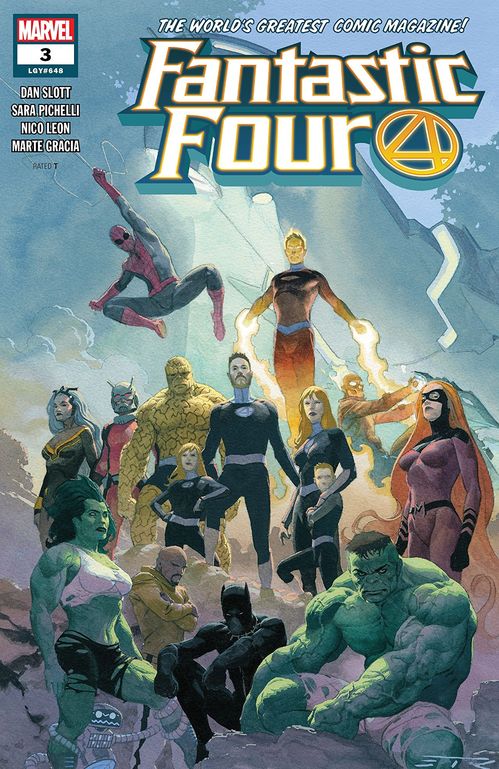
Fantastic Four Cover Art by Esad Ribic
5. Fantastic Four
Writer: Dan Slott
Artists: Sara Pichelli, Nico Leon, Others
First created by Jack Kirby and Stan Lee in 1961, the Fantastic Four has long been the thematic core of the Marvel Universe, although their sales rarely reflect the honored spot they hold in the hearts of many “True Believers.” The most recent Fantastic Four ongoing series concluded in 2015, and Reed and Sue Richards, their children and the Future Foundation think tank for young geniuses ended the epic Secret Wars event charting unexplored regions far, far away from Earth. Sue’s brother Johnny Storm, better known as the Human Torch, and family friend Ben Grimm, the Thing, stayed behind, tangling with the Inhumans and Guardians of the Galaxy before joining up for the excellent Marvel Two-in-One. This August, Marvel’s first family made its triumphant return…kind of. Fantastic Four was almost immediately hit with delays, taking some of the steam out of the momentous launch, and artist Sara Pichelli quickly began sharing interior duties with Nico Leon, with Aaron Kuder at bat for the next arc. That isn’t to say that the series under-delivers; Slott has previously written The Thing and the Human Torch, and he slips into the rest of the cast’s voices just as easily, resulting in one of the most heartwarming arcs the Richards clan has ever seen. In just a few issues, new codenames have been adopted, proposals have been made and accepted and elders of the universe have been defeated (for now). At the heart of each issue is one guiding principle: family first. Following the Fantastic Four has required a lot of patience in the modern era, but under Slott and company, it’s certainly paying off. Steve Foxe
![]()
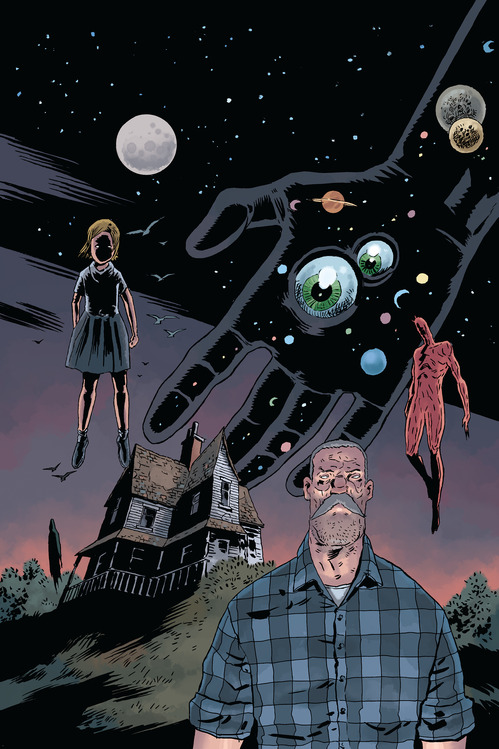
Black Hammer: Age of Doom Cover Art by Dean Ormston
4. Black Hammer: Age of Doom/ Black Hammer: The Quantum Age
Writer: Jeff Lemire
Artists: Dean Ormston, Rich Tommaso & Wilfredo Torres
Publisher: Dark Horse Comics
While the somber saga of Doctor Star kept Black Hammer on shelves at the beginning of the year, the cliffhanger ending of Black Hammer #13 in 2017 left readers dying to learn more about the franchise’s primary mystery. Age of Doom picked up right where that issue left off, but if you thought Jeff Lemire and Dean Ormston were going to dive right into concrete answers, you clearly haven’t been following this book. Lucy Webber, now the new Black Hammer, quickly found herself immersed in a side of the Black Hammer world we’ve barely glimpsed: its Vertigo analogue. While the main cast on the farm draw inspiration from DC Comics’ Golden and Silver Age heroes and villains, the new additions introduced in Age of Doom seem to owe a great debt to Karen Berger’s initial class of Vertigo madness. Artist Dean Ormston, a veteran of Vertigo books like Lucifer and Books of Magick, is at his best rendering the darker, more disturbing side of Lemire’s “Lemireverse,” and follow-up artist Rich Tommaso’s off-kilter pop-art style perfectly matched the more abstract, meta vibe of the book’s second arc. If vintage Grant Morrison and Peter Milligan isn’t your speed, Black Hammer: The Quantum Age saw Lemire team with Wilfredo Torres for the best Legion of Superheroes relaunch not legally approved by DC Comics. Torres’ slick linework and Lemire’s deep affection for the original property combined to craft and instantly recognizable far-flung future for the Black Hammer cast, simultaneously deepening the lore and reaching into uncharted territory with new cast members. There was a moment when Doctor Star’s downbeat ending seemed to pose the question: do we need this much out of Black Hammer? Age of Doom and The Quantum Age answer that question with a resounding yes. Steve Foxe
![]()
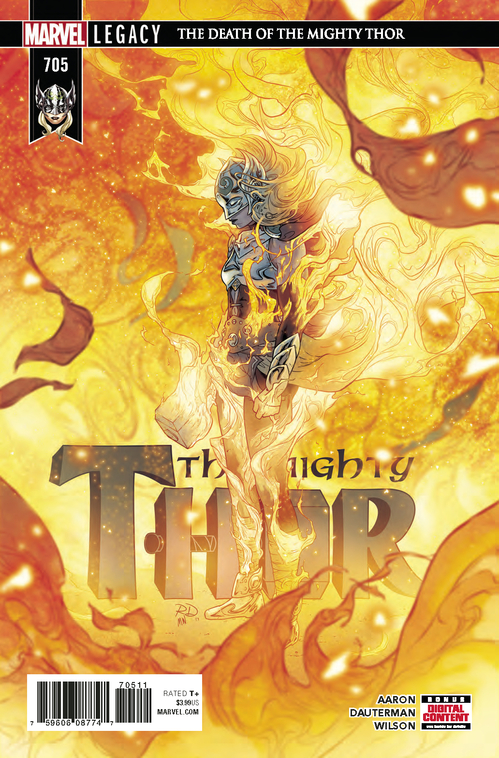
The Mighty Thor Cover Art by Russell Dauterman
3. The Mighty Thor
Writer: Jason Aaron
Artist: Russell Dauterman
Publisher: Marvel Comics
In the fall of 2014, readers met an all-new, all-different version of Thor. The long blond hair, red cape, winged helmet and mighty hammer were still there, but under all of the trappings of the God of Thunder was a woman. Odinson had lost the right to wield Mjolnir, and over the first few issues of the series, readers discovered that the new Thor was none other than former Thor love interest and supporting character Jane Foster, riddled with cancer but still trying to do her part to protect others. “Lady Thor” as she was both affectionately and derisively known, was in many ways the standard bearer for a new age at Marvel: Thor was a woman, and soon enough Captain America was a black man and even later than that Iron Man was a young black woman, Hulk was a Korean-American teen and so on. There were over a dozen shake-ups across the Marvel books, with the biggest names in the MCU looking very different than before. Mighty Thor #705 earlier this year marked the end of the era of Lady Thor, and in many ways the end of an even larger era at Marvel. Most of the changes that have debuted in the last few years have been reversed, part of the “Fresh Start” reboot in May. This run of Mighty Thor has been fascinating not only for the responses it garnered from readers, but because it put both Odinson and Jane Foster in uncommon positions, both vulnerable and flawed, each striving for something beyond themselves. In Odinson’s case, he lost the identity he constructed for himself; in Jane’s, she was confronting her own mortality while simultaneously wielding more power than ever before. Jane was allowed to be both a strong, invincible superhero and a fragile, ill woman, with a dignity and grace that is hard to come by in any media, let alone a mainstream superhero comic book. Jason Aaron, Russell Dauterman and Matt Wilson have spent the last three and a half years making something truly remarkable together, and their final arc before Thor relaunched with the Odinson as the lead, “The Death of the Mighty Thor,” is an important one to note. Caitlin Rosberg
![]()

X-Men Red Cover Art by Jenny Frison
2. X-Men Red
Writer: Tom Taylor
Artists: Mahmud Asrar, Carmen Carnero, Roge Antonio
Publisher: Marvel Comics
While there’s something to be said for telling a complete, distinct story and then dipping out, it’s hard not to feel like the reign of X-Men Red was unfairly cut short—especially given the uneven quality of the current Uncanny X-Men run that seems to have contributed to its demise. Still, 11 near-perfect issues are better than none, and Tom Taylor, Mahmud Asrar, Carmen Carnero and Roge Antonio made every page (and every character in the expansive roster) count. Jean Grey’s return was always inevitable, but there was never any guarantee it would be this damn good or timely, or that Taylor would be able to position her as the franchise figurehead in such a short amount of time. Taylor and his collaborators tapped into the social-media age to weaponize not just hate and bigotry, but hope and empathy, too. Asrar’s premature departure could have hobbled the run, but both Carnero and Antonio brought their A-games, and there’s little doubt that Red fits neatly in the line of New X-Men, Astonishing X-Men, Uncanny X-Force and Wolverine and the X-Men as an all-time great modern run. There’s plenty to look forward to in the mutant corner of 2019, but it’s hard to imagine any of it’ll top X-Men Red. Steve Foxe
![]()
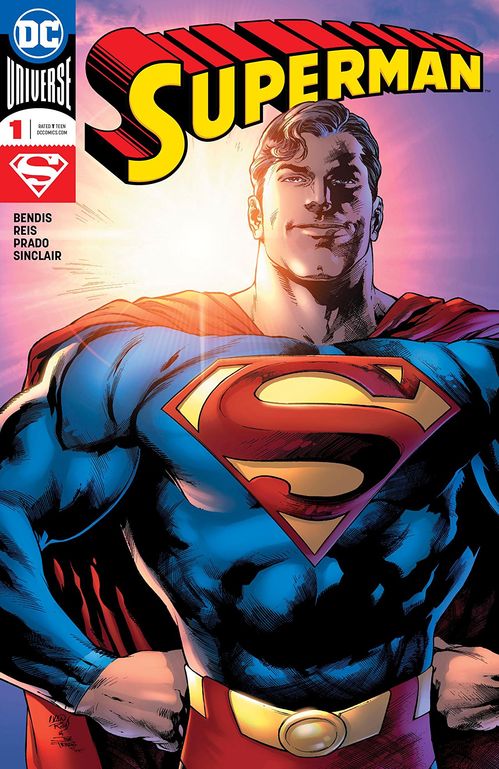
Superman Cover Art by Ivan Reis
1. Superman & Action Comics
Writer: Brian Michael Bendis
Artists: Ryan Sook, Ivan Reis, Others
Publisher: DC Comics
Yes, Action Comics placed highly in the middle of our 25 Best Comics of 2018 list, but when measured against the metric of the purely superheroic, there was little question that the one-two Kryptonian punch of Action Comics and Superman would come out on top. As we’ve said before, Paste wasn’t too impressed by Brian Michael Bendis’ first two Superman shorts in Actions Comics #1000 and DC Nation #0, but it didn’t take long for the newly exclusive DC writer to prove that his take on the Man of Steel wasn’t just a retread of his Marvel Comics work. Bendis gets Superman, and that goes for both the costumed hero and the bespectacled reporter. Both Superman and Action Comics have had core ongoing plots—Rogol Zaar in the former and organized crime in the latter—but Bendis isn’t really plotting tightly for the trade here, but seems to be almost luxuriating in the opportunity to explore Superman’s innate goodness. Two issues in particular stand out: Action Comics #1004, illustrated by Ryan Sook, is the most genuinely romantic story you’ll read in a mainstream superhero book all year, with a final page likely to bring a tear to your eye; and Superman #6, which opens with a stunning series of full-spread fight scenes from Ivan Reis as Superman debates, at super-speed, whether or not he can let Zod and Rogal Zaar kill each other. If you’ve been on the fence about the Bendis Super-era so far, let it be known: this is the S-shield standard-bearer we’ve been waiting for—and a pair of superhero comics so good, so pure, that we almost don’t deserve them. Steve Foxe